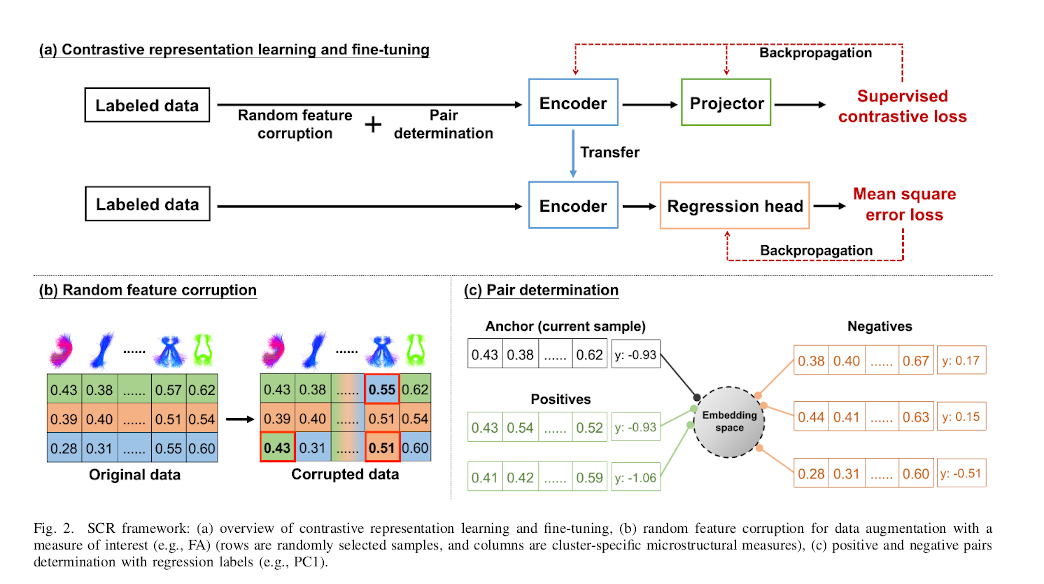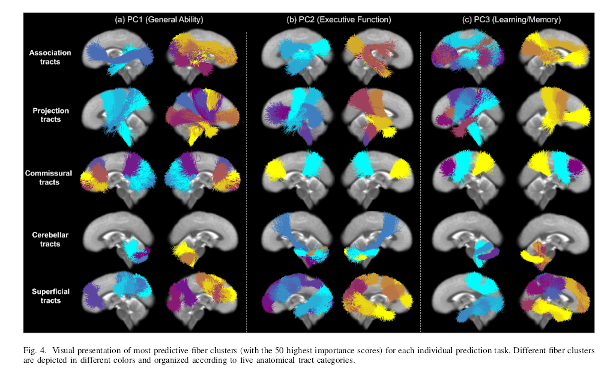A Novel Supervised Contrastive Regression Framework for Prediction of Neurocognitive Measures Using Multi-Site Harmonized Diffusion MRI Tractography
Introduction
The accuracy of current models for predicting neurocognitive measures using white matte (WM) measures extracted from diffusion MRI tractography (dMRI) is low. Authors propose a Supervised Contrastive Regression (SCR) framework to solve the task.
Methods
SCR is a supervised contrastive learning method to perform regression on continuous labels: authors
- Propose to use the absolute difference between labels to determine the positive and negative sample pairs for contrastive learning.
- They extract 3 measures (fractional anisotropy (FA), mean diffusivity (MD), and the number of streamlines (NoS)) from dMRI data and project them into the identified tractography bundles.
- Use a permutation feature importance algorithm to identify the relevance of the tractography clusters in the prediction.
- Use a different network for each dMRI feature and use ensemble learning.
Three neurocognitive scores are studied:
- General Ability
- Executive Function
- Learning/Memory

The parcellation was conducted using an atlas (including both deep and superficial WM bundles, DWM, SWM) developed at the same research group and the White Matter Analysis (WMA) software.
Figure 2 shows the method steps:

The projection network is an MLP or a single linear layer (FC).
The threshold value to determine whether two labels are considered as positive or negative pairs is experimentally set.
Loss:

Once the supervised contrastive learning is finished, the encoder is frozen and a regression head is added and trained on the mean squared loss (MSE) on the scores to be prediced.
Authors use 10-fold cross validation.
For the bundle relevance identification, authors permute 10% of the features randomly and measure the impact in performance to identify which features have the largest impact.
Data
8735 subjects from the Adolescent Brain Cognitive Development (ABCD) Study.
dMRI data was harmonized using a method1 from the same research group.
Evaluation
The Pearson correlation coefficient is reported between the ground truth scores and the predicted scores.
Results


Conclusions
Authors find that:
- SCR improves the accuracy for neurocognitive score prediction compared to other state-of-the-art methods.
- The most predictive fiber clusters are predominantly in the SWM and projection tracts.
References
Notes
Authors say that they use an MLP as their network model.
Slighlty related to https://vitalab.github.io/article/2022/09/30/WMTractsPointClouds.html
-
S. Cetin Karayumak et al., “Retrospective harmonization of multi-site diffusion MRI data acquired with different acquisition parameters,” Neuroimage, vol. 184, pp. 180-200, 2019. ↩